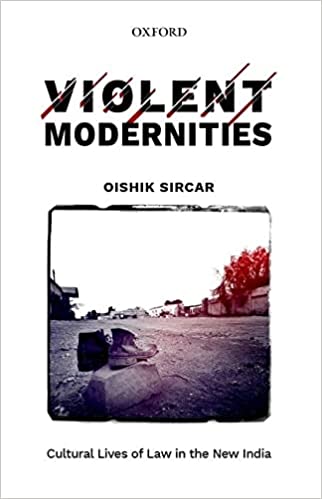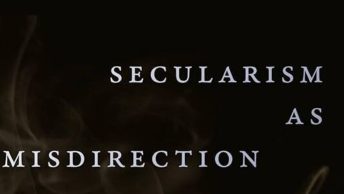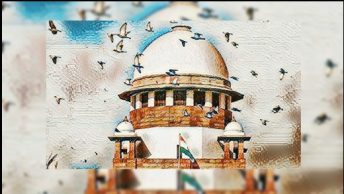[Ed Note: Over the next few days, we we will be runing a book discussion on Oishik Sircar’s “Violent Modernities: Cultural Lives of Law in New India”. This is Part II of a two-part review by Atreyee Majumder. Part I can be found here. The introductory post by Adil Hasan Khan can be found here, and the reviews by Siddharth Narrain and Nivedita Menon can be found here and here respectively. ]
On Matter
- Spectacles of Emancipation
The first chapter of Oishik Sircar’s Violent Modernities: Cultural Lives of Law in the New India, titled ‘Spectacles of Emancipation’ reflects on the spectacular break with the past that is engendered by the adoption of a postcolonial constitution, using Guy Debord’s The Society of the Spectacle (Sircar 2021: 10). Sircar, powerfully uses the short story by Saadat Hasan Manto, Ustad Mangu, in which a tongawalla, Ustad Mangu, literally imagines the new Constitution (Government of India Act, 1935) as a redemptive spectacle that would rid India of British oppression. This chapter imagines various modern, post-1991 Indian characters including Binayak Sen, Soni Sori, Irom Sharmila, Arun Fereira, and disenfranchised Adivasi communities as versions of Manto’s Ustad Mangu. This is a powerful trope, and it deploys law as matter and metaphor both. There is an interesting section on judgments of the higher judiciary in PILs that promise higher, lofty ideals and in the end take conservative positions (for instance, the UCC decision in the Bhopal Gas Leak case, the Almitra Patel judgment, or the Narmada Bachao Andolan judgment). Sircar shows three generations of PIL, the last being one that concerns itself thoroughly with economic progress of the nation-state (following Radha D’Souza, cf. Sircar 2021: 32).
Sircar takes, at the end of the chapter, a Chakrabarty-esque (borrowed from Provincializing Europe: Chakrabarty 2002) stance coining the terms Emancipation 1 and 2, the former being legalistic rights/court-based reliefs, while the latter lies in “contested cultures of the quotidian, the cacophonous politics of the street, and the mundane negotiations of the everyday and the ordinary” (Sircar 2021: 46). This formulation is hurriedly dealt with, whereas it could have been the central theme in the chapter. Sircar praises Chakrabarty’s scholarship but does not actually show how History 1 and 2, as a formula for ‘homogeneous, empty time’ (Benjamin 1969[1940]) built by the historical flow of capital and its non-western iterant, is related to Sircar’s formulation of the two registers of liberatory relief from state power.
- Beyond Compassion
In the second chapter, titled ‘Beyond Compassion’, which in the end, is my favourite in this collection, Dutta and Sircar hang out with children of sex workers in Sonagachhi, Kolkata. They sensitively bring out narratives of children in these neighbourhoods. The main argument is about the construction of ‘suffering’ children as objects of ‘compassion’ through liberal mediatisation (they especially talk about two documentary films, Born in Brothels by Briski and Kauffman and Selling of Innocents by Ruchira Gupta) and rests on a critique of compassion as a liberal sentiment. They particularly follow the activities of a children/adolescent-run initiative Amra Padatik (AP) (Dutta & Sircar 2021: 55). Dutta and Sircar criticise the liberal move of aestheticising suffering and rendering it a beautiful object- in this case, an innocent, suffering child whose depiction evokes pity in the liberal audience and concomitantly, a move to rescue. They further discuss famous photographs that stand as cases in point in demonstration of this phenomenon of aestheticising suffering – significantly, the 1972 image of the naked girl running after the napalm bomb dropped in her village (by Phan Thi Kim Phuc) and the Kevin Carter photograph of an emaciated girl crawling on her way to a UN Food Camp in Sudan. Dutta and Sircar briefly discuss the impact of the image in generating certain politically correct (“do-gooding”) responses from the global (western?) audience in which a certain teleology of a child’s life is assumed (Dutta & Sircar 2021: 62). They see it through Guy Debord’s formulation of compassionate responses as a ‘graveyard of good intentions’ (Debord 1983, cf. Dutta & Sircar 2021: 63). I notice that, especially in discussing image/photograph/film, the authors do not engage with Sontag’s now-classic On Photography (1977) where she discusses, amidst other visual art, the famous napalm girl photograph. Sontag’s answer to this compassion problem, lies in her theorization of the camera (Sontag 1977: 176):
Two attitudes underlie this presumption that anything in the world is material for the camera. One finds that there is beauty or at least interest in everything, see with an acute enough eye. (And the aestheticizing of reality that makes everything, anything, available to the camera is what also utterly practical sort, as art.) The other treats everything as the object of some present or future use, as matter for estimates, decisions, and predictions…Cameras implement as aesthetic view of reality by being a machine-toy that extends to everyone the possibility of making disinterested judgments about importance, interest, beauty.
It is this disinterested compassion that, I think, Dutta and Sircar are getting at, though they write that liberal compassion itself is a problem. I would invite them to bring the presence of the camera into the argument and consider its manipulative impact on the helpless, fair-trade-coffee-drinking bourgeoisie who routinely consume these art objects and feel such compassion.
The most powerful commentary, in this chapter, comes at the very end where Dutta and Sircar themselves make a documentary film We are Foot Soldiers on the narratives of these children/adolescents. They are aware of and honest about the power relations that they bring to the table in their access to and intimacy with their research subjects, as well as their good intentions in wanting to give expression to the narratives of the children who emerge as confident and fearless about confronting the world as surefooted political agents. The narratives of Chaitali and Gobinda are particularly evocative. As an anthropologist, I ask: would Dutta and Sircar call the film a work of ethnography? If so, what kinds of conversations did they have at the point of Human Subjects Clearance process about the ethical implications of using the narratives of minors. I would have liked to hear more about the authors’ own analysis of their method.
- Law and Aesthetics
The third chapter, titled ‘Bollywood’s Law’, discusses the presence of law’s active perpetration of violence and absence/silence on the occasion of socially mediated acts of violence; it does so through two films, primarily, Kai Po Che (2013) and the Govind Nihalani film Dev (2004). I won’t go deeply into Sircar’s critical discussion of the two films. I will focus my comments on the argument about law and aesthetics. Sircar writes, citing Jan Assman: “The aesthetic provides the fictive grounding for the film, while the legal provides the traction for masking, or appealing to, or truth claims” (Sircar 2021: 100-101). He discusses several theorists who have commented on the relationship between law and image, on the challenge posed by the ambiguity and viscerality of an image to the attempt of law to provide order and stability (Sircar 2021: 101). The question of law’s interaction with an image, seems to me, separate from the question of law and aesthetics. One could (and I would agree) argue that law itself is an aesthetic arrangement of reality; the craving for order and stability is an aesthetic. In separating law and the aesthetic, I think Sircar essentializes both law and the aesthetic. He quotes Clifford Geertz to hint exactly at this idea, where Geertz calls law a ’distinct manner of imagining the real’ (Geertz 1983, cf. Sircar 2021: 102). But Sircar shies away from taking Geertz’s point through to its logical conclusion. Finally, I remain troubled by the attribution of the idea of ‘collective memory’ to Emile Durkheim. Durkheim coined the term ‘collective effervescence’ in the canonical text Elementary Forms of Religious Life (1995[1912]). Maurice Halbwachs, who I haven’t read, claims Durkheim’s term as a way of expressing the process of active remembering by a community. I wanted, here, a more thorough explanation of this term, ‘collective memory’ and its usage of Durkheim.
Sircar ends with the provocation of cinema as minor jurisprudence. I understand him, here, as saying that a ‘minor jurisprudence’ is an archive of law that pushes back against the ur-texts of the law. Sircar writes: “Creating a hierarchy between law and aesthetics defeats the very aim of thinking about their conjoined habitus – narrative compact – in the making of collective memory, and their consequent ordering through juridical developmental rationality. Rather, my account of minor jurisprudence in reading Dev is a story of complicities – between law and aesthetics, their inflections and contaminations, their leakages and seepages” (Sircar 2021: 113). Other than a common-sense perception of these two terms of law and aesthetics being alien to each other, I don’t see why and how the author shows them, first, as separate, opposing entities, which then, he surprises us by showing leakages and seepages in and through. I remain uncomfortable about his coinage, later in the chapter, of the term ‘jurisprudential-aesthetic’ (Sircar 2021: 115-116). To my mind, the jurisprudential is always, already aesthetic.
Sircar writes: “In the ‘world of danger’ that the film conjures, Dev and his Gita-inspired juridico-moral universe offers succour for ‘certainty and security’ and embodies the role of the ‘father substitute’” (Sircar 2021: 128). Religion has acted throughout modern history as the horizon that encapsulates possibility of radical change and/or action. I am troubled by the assertion that a policeman deriving his morality out of a religious text (clarifying his notion of what is to be done, when the orders from the government seem contrary to his inner morality) at a time of crisis, should be the basis for an argument about the crisis of secular. I side here, with Ashis Nandy, in asserting that it is revulsion at anything publicly religious that has been actively responsible for the rise of belligerent Hindu right wing factions in India.
- Stuckness
The fourth chapter, titled ‘New Queer Politics’, shows the mainstreaming of sexuality politics and its quiet co-option into the neoliberal-Hindu-right combine. This is an argument, I have heard and appreciated, in internal critiques among activists and academics who work in and with sexuality politics. It ends with an interesting evocation of Lauren Berlant’s term ‘performance of stuckness’ (Berlant 2014, cf. Sircar 2021: 177), and simultaneously Mbembe’s term ‘a negative moment’. Mbembe writes: “A negative moment is a moment when new antagonisms emerge while old ones remain unresolved. It is a moment when contradictory forces – inchoate, fractured, fragmented – are at work but what might come out of their interaction is anything but certain” (Mbembe 2015, cf. Sircar 2021: 177-178). Sircar reflects, through these terms, on the value or lack thereof, of being an active ally in a movement while constantly noticing and living with its complicity in larger structures of violence. Sircar writes, in poetic words: “I feel a combined sense of both fear and pleasure at getting stuck in this negative moment in New India” (Sircar 2021: 178). I am listening to Lata Mangeshkar sing against strong drumbeats: aaj phir jeene ki tamanna hai/aaj phir marne ka irada hai. A rehearsal of a desperate, morbid hope in a time of darkness, mirrors Sircar’s lines. I wish the series of essays were organized around these terms, where the author is very honestly trying to think through his politics in a time of fear and peril. (Sircar, in the first endnote of this chapter, writes that he is deeply suspicious of both universalism and relativism. This is telling, and it reveals something about his intellectual and political lives. I wish this had been unpacked in greater detail in the first chapter or the Preface itself, as a kind of methodological unravelling.)
On Manner
The second half of the book, consisting of three chapters, are written as reflective essays, the last two as intellectual memoirs. I didn’t care so much for the last two chapters that recount anecdotes of when the author met Upendra Baxi at a conference, or when a Canadian Professor asked the author to ‘take a break from feminism’. These two chapters did not yield much for me except as a recount of the intellectual genealogy of the author. But I will comment a bit on the fifth chapter, titled ‘The Silence of Gulberg’, which is an excellent one. Here, the author recounts his travel to Ahmedabad as part of a fact-finding group and visited the famous Gulberg Society where much atrocity took place during the 2002 riots. Sircar writes sensitively about meeting two characters, Farooq and Imtiaz, and talks with them about their memories of the massacre of 2002. Sircar writes a wonderful section on solitude and silence and curates a number of poignant photographs (taken by the author himself) in the Gulberg Society. The residue of all that violence is today’s ‘affect of abandonment’ which, Sircar claims, could not be contained in word or image (Sircar 2021: 201). He ends the chapter with an equally evocative passage about the chorus of children laughing as they came out of a dargah. This is how, life repairs, I thought, remembering Veena Das’s classic ethnography of silence and suffering and the everyday (Das 2006). Sircar writes in humour and pathos: “I never knew that the power of collective laughter could not only heal but also arrest cycles of violence” (Sircar 2021: 208). Here, I wish he had pushed further and written a bit about the effect and implication of childlike laughter in a scene of iconic violence. I feel he relegated laughter to the domain of the aesthetic, rendering it somehow devoid of political charge.
Works Cited
- Benjamin, Walter. Theses on the Philosophy of History. In Illuminations: Essays and Reflections. Harry Zohn (trans.). New York, NY: Schocken Books, 1969.
- Das, Veena. Life and Words: Violence and the Descent into the Ordinary. Berkeley, CA: Univ. of California Press, 2006.
- Durkheim, Emile. The Elementary Forms of Religious Life. Karen E Fields (trans.). New York, NY: The Free Press, 1995 (1912).
Atreyee Majumder is an anthropologist. She earned her doctoral degree from Yale University and has been an Andrew Mellon Postdoctoral Fellow at the Jackman Humanities Institute, University of Toronto. She is currently Assistant Professor of Sociology at the National Law School of India University, Bengaluru.






[…] Posted byAtreyee Majumdar […]